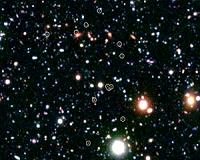 |
Greenbelt MD (SPX) Jan 14, 2011 The combined data from several NASA satellites has astonished astronomers by revealing unexpected changes in X-ray emission from the Crab Nebula, once thought to be the steadiest high-energy source in the sky. "For 40 years, most astronomers regarded the Crab as a standard candle," said Colleen Wilson-Hodge, an astrophysicist at NASA's Marshall Space Flight Center in Huntsville, Ala., who presented the findings at the American Astronomical Society meeting in Seattle. "Now, for the first time, we're clearly seeing how much our candle flickers." The Crab Nebula is the wreckage of an exploded star whose light reached Earth in 1054. It is one of the most studied objects in the sky. At the heart of an expanding gas cloud lies what's left of the original star's core, a superdense neutron star that spins 30 times a second. All of the Crab's high-energy emissions are thought to be the result of physical processes that tap into this rapid spin. For decades, astronomers have regarded the Crab's X-ray emissions as so stable that they've used it to calibrate space-borne instruments. They also customarily describe the emissions of other high-energy sources in "millicrabs," a unit derived from the nebula's output. "The Crab Nebula is a cornerstone of high-energy astrophysics," said team member Mike Cherry at Louisiana State University in Baton Rouge, La. (LSU), "and this study shows us that our foundation is slightly askew." The story unfolded when Cherry and Gary Case, also at LSU, first noticed the Crab's dimming in observations by the Gamma-ray Burst Monitor (GBM) aboard NASA's Fermi Gamma-ray Space Telescope. The team then analyzed GBM observations of the object from August 2008 to July 2010 and found an unexpected but steady decline of several percent at four different "hard" X-ray energies, from 12,000 to 500,000 electron volts (eV). For comparison, visible light has energies between 2 and 3 eV. With the Crab's apparent constancy well established, the scientists needed to prove that the fadeout was real and was not an instrumental problem associated with the GBM. "If only one satellite instrument had reported this, no one would have believed it," Wilson-Hodge said. So the team amassed data from the fleet of sensitive X-ray observatories now in orbit: NASA's Rossi X-Ray Timing Explorer (RXTE) and Swift satellites and the European Space Agency's International Gamma-Ray Astrophysics Laboratory (INTEGRAL). The results confirm a real intensity decline of about 7 percent at energies between 15,000 to 50,000 eV over two years. They also show that the Crab has brightened and faded by as much as 3.5 percent a year since 1999. The scientists say that astronomers will need to find new ways to calibrate instruments in flight and to explore the possible effects of the inconstant Crab on past findings. A paper on the results will appear in the Feb. 1 issue of The Astrophysical Journal Letters. Fermi's other instrument, the Large Area Telescope, has detected unprecedented gamma-ray flares from the Crab, showing that it is also surprisingly variable at much higher energies. A study of these events was published Thursday, Jan. 6, in Science Express. The nebula's power comes from the central neutron star, which is also a pulsar that emits fast, regular radio and X-ray pulses. This pulsed emission exhibits no changes associated with the decline, so it cannot be the source. Instead, researchers suspect that the long-term changes probably occur in the nebula's central light-year, but observations with future telescopes will be needed to know for sure. This region is dominated by four high-energy structures: an X-ray-emitting jet; an outflow of particles moving near the speed of light, called a "pulsar wind"; a disk of accumulating particles where the wind terminates; and a shock front where the wind abruptly slows. "This environment is dominated by the pulsar's magnetic field, which we suspect is organized precariously," said Roger Blandford, who directs the Kavli Institute for Particle Astrophysics and Cosmology, jointly located at the Department of Energy's SLAC National Accelerator Laboratory and Stanford University. "The X-ray changes may involve some rearrangement of the magnetic field, but just where this happens is a mystery." The Crab Nebula is a supernova remnant located 6,500 light-years away in the constellation Taurus. NASA's Fermi is an astrophysics and particle physics partnership managed by NASA's Goddard Space Flight Center in Greenbelt, Md., and developed in collaboration with the U.S. Department of Energy, with important contributions from academic institutions and partners in France, Germany, Italy, Japan, Sweden and the United States. The GBM Instrument Operations Center is located at the National Space Science Technology Center in Huntsville, Ala. The team includes a collaboration of scientists from UAH, NASA's Marshall Space Flight Center in Huntsville, the Max Planck Institute for Extraterrestrial Physics in Germany and other institutions. NASA Goddard manages Swift, RXTE and a guest observer facility for U.S. participation in the European Space Agency's INTEGRAL mission.
Share This Article With Planet Earth
Related Links Fermi at NASA Stellar Chemistry, The Universe And All Within It
 Most Distant Galaxy Cluster Identified
Most Distant Galaxy Cluster IdentifiedPasadena CA (JPL) Jan 14, 2011 Astronomers have uncovered a burgeoning galactic metropolis, the most distant known in the early universe. This ancient collection of galaxies presumably grew into a modern galaxy cluster similar to the massive ones seen today. The developing cluster, named COSMOS-AzTEC3, was discovered and characterized by multi-wavelength telescopes, including NASA's Spitzer, Chandra and Hubble space tel ... read more |
|
| The content herein, unless otherwise known to be public domain, are Copyright 1995-2010 - SpaceDaily. AFP and UPI Wire Stories are copyright Agence France-Presse and United Press International. ESA Portal Reports are copyright European Space Agency. All NASA sourced material is public domain. Additional copyrights may apply in whole or part to other bona fide parties. Advertising does not imply endorsement,agreement or approval of any opinions, statements or information provided by SpaceDaily on any Web page published or hosted by SpaceDaily. Privacy Statement |